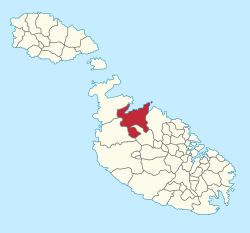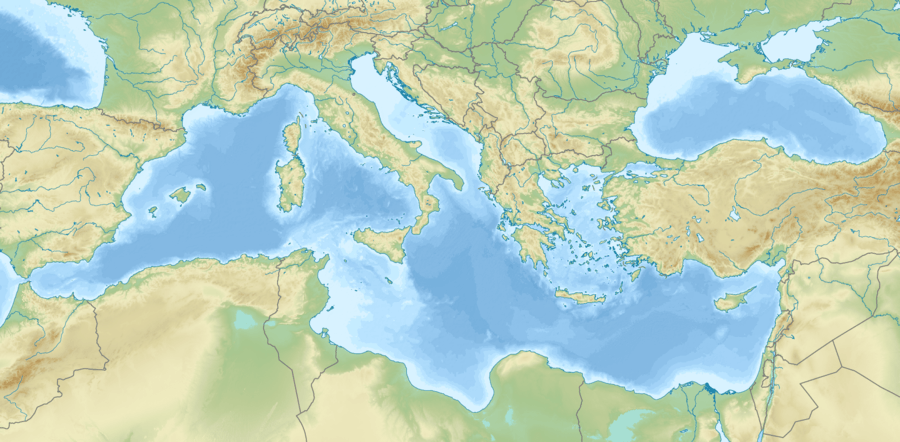Acts 27
Acts 27 is the twenty-seventh chapter of the Acts of the Apostles in the New Testament of the Christian Bible. It records the journey of Paul from Caesarea heading to Rome, but stranded for a time in Malta. The book containing this chapter is anonymous but early Christian tradition uniformly affirmed that Luke composed this book as well as the Gospel of Luke.[1]
| Acts 27 | |
|---|---|
 Acts 27:14-21 in Papyrus 74 (7th century) | |
| Book | Acts of the Apostles |
| Category | Church history |
| Christian Bible part | New Testament |
| Order in the Christian part | 5 |
Text
The original text was written in Koine Greek. This chapter is divided into 44 verses.
Textual witnesses
Some early manuscripts containing the text of this chapter are:
- Codex Vaticanus (AD 325–350)
- Codex Sinaiticus (330–360)
- Codex Bezae (~400)
- Codex Alexandrinus (400–440)
- Codex Ephraemi Rescriptus (~450; extant verses 17–44)
Locations

This chapter mentions or alludes to the following places (in order of appearance):
Verse 1
- And when it was determined that we should sail into Italy, they delivered Paul and certain other prisoners unto one named Julius, a centurion of Augustus' band.[2]
- "Agustus' band": or "Augustan Regiment" (NKJV).
Verse 2
- And entering into a ship of Adramyttium, we launched, meaning to sail by the coasts of Asia; one Aristarchus, a Macedonian of Thessalonica, being with us.[3]
- "Aristarchus": One of Paul's travel companions, a Macedonian from Thessalonica, who is known from some references in the Acts of the Apostles (19:29; 20:4; 27:2) and Colossians 4:10.[4]
Verse 21–26
In verses 21–26 Paul encourages and comforts those men on board, even though they had ignored his advice about sailing that he gave in verse 10.[5]
Verse 27-38
After fourteen days without eating, St Paul "took bread and gave thanks to God in the presence of all, and he broke it and began to eat" and 276 Christian believers had eaten their fill.
The verse recalls Jesus Christ God feeding the multitude and the words said by priest during the Eucharistic Consecration.
Calculation of position
The meteorological and nautical evidence demonstrates, and in rather spectacular fashion, that these events must have occurred just as Luke records them. The most important piece of evidence is the exact compass bearing of the gale. This bearing can be established by means of three separate calculations.
- First, Luke states that Euraquilo struck shortly after they left Fair Havens. In other words, the ship must have been less than halfway to their intended destination at Phoenix. They must have been somewhere between Cape Matala and a point seventeen miles W.N.W. of the Cape when the gale struck.
- Second, there is the relation of the island of Clauda (or Cauda) to this start point. Cape Matala is on a bearing of east 7 degrees north from the eastern edge of Clauda, while the halfway point to Phoenix is east 40 degrees north. For the ship to get behind Clauda, Euraquilo must have been blowing from a point somewhere between these two bearings. The point midway between these two figures is east 25 degrees north (or E.N.E. 1/4 N.). This cannot be more than a point and a half off the actual direction of the wind.
- Third, Luke states that when they got behind Clauda, the sailors were afraid that they would be blown onto the Syrtis sandbanks of north Africa. However, for them to have been blown onto those banks from Clauda, Euraquilo would have had to have been blowing from a point somewhere between east 18 degrees north and east 37 degrees north. The point midway between these figures is east 27 degrees north. This figure is only 1/4 point off the mean figure of the previous calculation.
These three calculations establish that the direction from which the wind was blowing could not have been more than a point off the designation E.N.E. 1/2 N. As the ship drifted west from Clauda, it would have been pointed due north, because it could not have been pointed directly into the wind without capsizing. In other words, it had to have been pointed north, just off the direction from which the wind was coming. Using this information, with some precision both the direction and rate of the ship’s drift to the west can be calculated.[6]
Ancient records reveal that Egyptian grain ships were the largest vessels of the time, being about the size of an early nineteenth century sailing vessel. This size is implicitly confirmed by Luke’s statement that there were 276 people on board. Since their ship was pointed due north, while the wind was from the northeast, the azimuth, or direction, of the ship’s lateral – or sideways – drift from Clauda would have been approximately west eight degrees north. The island of Malta is not directly west of Clauda. Instead, Malta’s bearing from Clauda is exactly west eight degrees north.[6]
This brings to yet another piece of evidence. Luke states that it took them fourteen days to drift to Malta. The distance from Clauda to the easternmost point of Malta is 476.6 miles. To calculate the westward rate of drift of their ship, it is necessary to know two things: the size of the ship and the force of the gale. As the approximate size of the ship is known, it is possible to establish the mean intensity of the gale. An average rate of drift for Paul’s vessel can then be calculated. This calculation reveals an average westward drift of one and one half miles per hour. Thus it would take Paul’s ship about thirteen days to drift to Malta. Luke records that it took them fourteen days. This nautical and meteorological evidence provides confirmation of the historical accuracy of Luke's narrative.[6]
Shipwreck location on Malta

Bob Cornuke and Graham Hutt claim that the location of the shipwreck was at St. Thomas Bay on the southeast of Malta on a sandbar called Muxnar Reef. However the traditional location is called St. Paul's Bay. Four Roman era anchors from this location are in the Malta Maritime Museum in Birgu.[7] The nearby city, Valletta, hosts a church named 'Collegiate Parish Church of St Paul's Shipwreck'. Yet another theory is that the shipwreck was off Qawra Point and outside Salina Bay. A number of anchor stocks have been found in the area.[8]
Applications
Matthew Henry draws out several points from this chapter to apply to lives of Christians. From verses 1–11 he draws an analogy with those that do not make any headway in life, they fail to take advantage of favourable conditions, even if they resist being driven backwards. Many complain of the great effort just to stay in one place. But then fail to take advantage of good advice to advance in life. Also not all fair havens are safe havens.[5] On verses 12-20 it states that one should not assume the purpose is achieved when starting out. Blessing of the world can turn out to be an unwanted burden, and may have to be discarded, just as things were thrown off the ship in the storm. It is better to make a shipwreck of one's goods than of one's life. But some do the reverse. In the same way that the efforts of the sailors proved useless to saving the ship, and safety only resulted when they gave up, sinners have to give up on saving themselves and rely on the mercy of Jesus.[5] On verses 21–29 Matthew Henry makes the point that those that are interest in God's promises should be ever cheerful, because God is faithful. Hope is an anchor for the soul.[5] On verses 30–38 Matthew Henry's point is that people should take proper safety precautions and not tempt God by failing to take them, and only trusting in him. It is selfish to only look after our own safety at the expense of others. (Commenting on the sailors trying to get away in the lifeboat by themselves). Salvation is via God's plan, which is repentance, faith, prayer and obedience, and not some other shortcut.[5] On verses 39–44 he comments that a heart stuck to the world will be lost.[5]
References
- Holman Illustrated Bible Handbook. Holman Bible Publishers, Nashville, Tennessee. 2012.
- Acts 27:1 KJV
- Acts 27:2 KJV
- Murphy-O'Connor, Jerome (2007). "70. Colossians". In Barton, John; Muddiman, John (eds.). The Oxford Bible Commentary (first (paperback) ed.). Oxford University Press. p. 1198. ISBN 978-0199277186. Retrieved February 6, 2019.
- "Acts 27". Matthew Henry’s Concise Commentary.
- Paul's Shipwreck on Malta Archived 2014-11-02 at the Wayback Machine from the "Evidence and Paul's Journeys" (Paperback) by Jefferson White. Publisher: Parsagard Press (January 24, 2001). ISBN 978-0970569509
- "Searching for Paul's Shipwreck on Malta". CBN.com (beta). CBN. 30 January 2015. Retrieved 17 June 2017.
- Franz, Gordon (13 September 2012). "Benedict's Anchor: Was It From the Shipwreck of the Apostle Paul on Malta?". www.biblearchaeology.org. Archived from the original on 12 June 2017. Retrieved 17 June 2017.
External links
- Acts 27 King James Bible - Wikisource
- English Translation with Parallel Latin Vulgate
- Online Bible at GospelHall.org (ESV, KJV, Darby, American Standard Version, Bible in Basic English)
- Multiple bible versions at Bible Gateway (NKJV, NIV, NRSV etc.)
